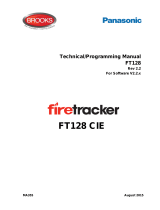Page is loading ...

1
Fire detection and evacuation solutions that save lives.
Alarm Acknowledgement Facility (AAF)
Installation guide
MAN1569-4

MAN1569-4
2
Description
The “loop powered” Alarm Acknowledgement Facility (AAF) is designed to work in conjunction with the
Ampac FireFinder Fire Alarm Control Panel (FACP) and Apollo analogue detectors.
When an alarm condition occurs in a room, the sounder at the local AAF is activated. At this stage the signal
to the fire alarm and emergency warning system is inhibited and the 0 to 60-second “Alarm
Acknowledgement Period” is activated.
During the alarm acknowledgement period the occupant of the room can acknowledge the alarm by pressing
a button located on the AAF. Acknowledging the alarm will silence the local sounder and activate the 0 to
180- second “Investigation Period”.
At the end of the investigation period the AAF is interrogated. If the alarm condition still exists, the FireFinder
will go into general fire alarm mode thereby activating the signal to the fire brigade and emergency warning
system. The FireFinder will also go into general fire alarm mode if the local alarm was not acknowledged
within the alarm acknowledgement period.
ConfigManager is programmed to identify the associations of AAF’s with audible devices and adjustment of
the “Acknowledgement” and “Investigation” periods.
AM Features
➢ Loop interface with Short Circuit Isolator (SCI)
➢ On-board Hush Switch with integrated front panel , Fire LED (red) and external hush input
➢ Indicators: Poll / SCI LED (green – behind cover), Fault LED (yellow – behind cover)
ADDRESS SWITCH
EXT. HUSH / POLL
SELECTION
SWITCH
POLL LED
FAULT LED
ALARM LED
LOOP IN/OUT -VE
LOOP IN/OUT +VE
EXTERNAL "HUSH"
-
+
+
+
-
-
EOL
22K
4K7
NOTE
EOL MUST BE A APPLIED
EVEN IF THE FUNCTION IS UN-USED
FAULT TESTING
1. REMOVE HUSH EOL
POLL/SCI FAULTS
1. OPEN THE LOOP
2. SHORT THE LOOP
Figure 1: Alarm Acknowledgment Facility

MAN1569-4
3
Installation
Observe anti-static precautions at all times
1. Two DIP switches are provided, SW2 for addressing (8 way) and SW1 for module options (4 way) as
below.
DIP SW1
Name
Operational Parameters
1 & 2
Not used
3 Ext. Hush
Ext. HUSH Input
ON for monitoring the External Hush Input
4 Poll
Poll LED
ON for Poll LED operation
2. Establish the operational criteria for the module and configure the FACP software accordingly
3. Remove the white face plate and set the address and operational parameters via the dip switches
4. All cabling should be run into a general purpose wall box and connected as per Figure 1 below
5. The AM is then screwed to the wall box and tested – replace the face plate once testing is complete
Testing
1. Prepare the most suitable situation for the installation to test the AAF then create a local “alarm”
2. The alarm indicator should illuminate when the alarm is recognised by the AAF
3. Check the silence function, the configured “Acknowledgement” and “Investigation” timing
4. Introduce a fault condition eg 1. remove the “Ext. Hush” EOL, 2. check short circuit isolation operation.

MAN1569-4
4
Addressing DIL Switch Settings
DIL switch setting
DIL switch setting
DIL switch setting
DIL switch setting
DIL switch setting
Addr
1234567
Addr
1234567
Addr
1234567
Addr
1234567
Addr
1234567
1
1000000
26
0101100
51
1100110
76
0011001
101
1010011
2
0100000
27
1101100
52
0010110
77
1011001
102
0110011
3
1100000
28
0011100
53
1010110
78
0111001
103
1110011
4
0010000
29
1011100
54
0110110
79
1111001
104
0001011
5
1010000
30
0111100
55
1110110
80
0000101
105
1001011
6
0110000
31
1111100
56
0001110
81
1000101
106
0101011
7
1110000
32
0000010
57
1001110
82
0100101
107
1101011
8
0001000
33
1000010
58
0101110
83
1100101
108
0011011
9
1001000
34
0100010
59
1101110
84
0010101
109
1011011
10
0101000
35
1100010
60
0011110
85
1010101
110
0111011
11
1101000
36
0010010
61
1011110
86
0110101
111
1111011
12
0011000
37
1010010
62
0111110
87
1110101
112
0000111
13
1011000
38
0110010
63
1111110
88
0001101
113
1000111
14
0111000
39
1110010
64
0000001
89
1001101
114
0100111
15
1111000
40
0001010
65
1000001
90
0101101
115
1100111
16
0000100
41
1001010
66
0100001
91
1101101
116
0010111
17
1000100
42
0101010
67
1100001
92
0011101
117
1010111
18
0100100
43
1101010
68
0010001
93
1011101
118
0110111
19
1100100
44
0011010
69
1010001
94
0111101
119
1110111
20
0010100
45
1011010
70
0110001
95
1111101
120
0001111
21
1010100
46
0111010
71
1110001
96
0000011
121
1001111
22
0110100
47
1111010
72
0001001
97
1000011
122
0101111
23
1110100
48
0000110
73
1001001
98
0100011
123
1101111
24
0001100
49
1000110
74
0101001
99
1100011
124
0011111
25
1001100
50
0100110
75
1101001
100
0010011
125
1011111
126
0111111
Addressing Examples
Address 1
Address 34
Address 68
Address 8
/


